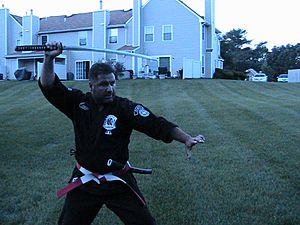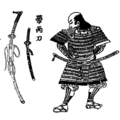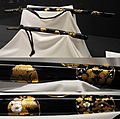Katana facts for kids
Quick facts for kids Katana |
|
|---|---|
|
Katana signed by Masamune with an inscription (Castle Izumi Mamoru possession) in gold inlay, Kamakura period, 14th century, blade length: 70.6 cm
|
|
| Type | Sword |
| Place of origin | Japan |
| Production history | |
| Produced | Muromachi period (1392–1573) to present |
| Specifications | |
| Mass | 1.1–1.3 kg |
| Blade length | approx. 60–73 cm (23+5⁄8–28+3⁄4 in) |
|
|
|
| Blade type | Curved, single-edged |
| Hilt type | Two-handed swept, with circular or squared guard |
| Scabbard/sheath | Lacquered wood |
A katana is a Japanese long sword used by samurai warriors. It is the most important sword of the three swords worn by samurai: katana, wakizashi, and tanto. The katana was popular from 1400 A.D. until 1876, when the samurai were abolished as a social class.
In Japanese, "katana" means a long sword and it represents a blade, which is a little curved, with a single edge and a very sharp point.
Contents
Types
There are several types of katanas:
- Artwork/old katana - nihonto
- Sharpened katana - shinsaku, shinken
- Modern katana designed for the training of iaido and iaijutsu - iaito
- Decorative, ceremonial katanas.
Forging and polishing
A traditional katana is made of a type of high carbon steel called tamahagane, which is made by smelting a type of Japanese iron ore, called iron sand, in a large furnace called a tatara.
This steel is sent to a smith who breaks it down to small pieces and layers the steel according to carbon content, they smelt this in their forge and repeatedly fold the steel in order to homogenise it. The most important part of the forging is the tempering, when the sword is quench-hardened. In ancient times it was said that the soul of the sword was put into the katana at this point. The sword is sometimes given a rough polish by the smith and then sent to a professional polisher for polishing (usually to a mirror finish). After polishing, the sword to be fitted.
Today katanas are mainly made of carbon steel of different quality. But there are some swords made of zinc and aluminum alloys, which are able to resist some external forces and are only used for decoration or non-tameshigiri practice. To determine the quality of a katana it is enough to check its resistance (how much it bends when it is hit), elasticity (the ability of katana to return to its original shape), and the endurance of the blade after striking (how long it lasts).
Wearing and use
Generally, katana is designed for cutting, but it was widely used for stabbing too. This depended mainly on the length of the tang (the handle). The katana could be easily used for cutting if it was made for using with both hands. It was used for stabbing when the katana was made for using with one hand.
As a rule, katana was worn under the belt on the left side of a right-handed man. The sword was in its sheath or scabbard (the cover), with its blade facing up. That way the sword could be drawn and cut the opponent in one movement. Alternatively, the scabbard might be held freely in the left hand: in action the sword would be drawn and the scabbard thrown down. This allows for free movement in battle.
To pull the katana a few inches out of its scabbard was an aggressive move signalling willingness to fight.
Katana and Japanese tradition
Katana was very important in Japanese society. This sword was thought to be the "soul" of its master. Only a samurai was allowed to have a katana. A simple man with a katana sword could be killed at once.
There was a tradition of wearing, taking care and taking the katana out of its scabbard. Samurai kept their katana on a special stand for swords, called katana-kake. This stand was used for both katana and wakizashi. The blade had to have its point up, just as when wearing the sword; the handle (called the tang) had to be turned to the left. This made katana available for handling any time it was needed.
The art of handling a katana was developed in martial arts like kenjutsu and iaijutsu. Today, this art is practiced in iaido and kendo martial arts. The last one is the art of dueling with bamboo or wooden sword. Old schools of handling katana swords still exist. The most famous are: Kashima Shin-ryu, Kashima Shinto-ryu, Tenshin Shoden Katori Shinto-ryu.
The most appreciated technique of handling a katana is a school called Nitto Ryu. This school taught how to use both a katana and a wakizashi during a fight. The most famous samurai who improved this art was Miyamoto Musashi.
Images for kids
-
Japanese Edo period wood block print (ca 1735) of a samurai with a tachi and a wakizashi (or kodachi).
-
A Sōshū school katana modified from a tachi, Kiriha Sadamune, forged by Sadamune, son of Masamune. 14th century, Kamakura period. Important Cultural Property. Tokyo National Museum
-
Muramasa (勢州桑名住村正) from the Tokyo National Museum
-
Daishō style handachi sword mounting. 16th-17th century, Azuchi–Momoyama or Edo period.
-
Antique Japanese daishō, the traditional pairing of two Japanese swords which were the symbol of the samurai, showing the traditional Japanese sword cases (koshirae) and the difference in size between the katana (bottom) and the smaller wakizashi (top).
-
Katana mountings decorated with maki-e lacquer in the 1800s. Although the number of forged swords decreased in the Meiji period, many artistically excellent mountings were made.
-
Japanese girl practicing iaidō with a modern training katana or iaitō. This sword was custom-made in Japan to suit the weight and size of the student. The blade is made of aluminum alloy and lacks a sharp edge for safety reasons.
-
Katana forged by Nagasone Kotetsu. The letters inlaid with gold on the tang (nakago) indicated that Yamano Kauemon (山野加右衛門), the official executioner of the Tokugawa shogunate and examiner of sword cutting performance, cut the four human torso overlapped.
-
Daishō style sword mounting, gold banding on red-lacquered ground. 16th century, Azuchi–Momoyama period. Important Cultural Property. Tokyo National Museum. These swords were owned by Toyotomi Hideyoshi.
-
Katana mounting with a polished black lacquer sheath, Edo period. Museum of Fine Arts, Boston.
-
Mounting for a katana forged by Motoshige. late 16th or early 17th century, Azuchi–Momoyama or Edo period. Important Cultural Property. Tokyo National Museum.
See also
 In Spanish: Katana para niños
In Spanish: Katana para niños






























